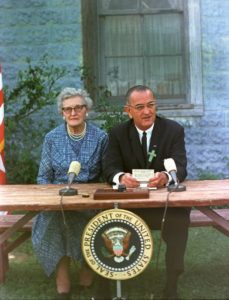
President Obama signs ESSA into law
On December 10, 2015, President Obama signed into law the Every Student Succeeds Act. ESSA, as it’s known, is the latest in a long history of federal mandates aimed at improving public education throughout the United States. ESSA replaces the earlier legislation signed by President George Bush in 2001, No Child Left Behind.
But prior to both ESSA and NCLB, was ESEA.
In 1965, President Lyndon Johnson signed into law the most sweeping education legislation of its time with the Elementary and Secondary Education Act. ESEA established things like Title 1 funding for schools with a high percentage of students from low-income families, as well as funding directed at improving the quality of elementary and secondary public education. President Johnson, himself, was intimately familiar with public education: before he became President, Johnson taught school in Texas in the late 1920s.

President Johnson and his teacher, Kate Deadrich Loney
Moreover, he saw the devastating effects poverty had on students: “My first job after college was as a teacher in Cotulla, Texas, in a small Mexican-American school. Few of them could speak English and I couldn’t speak much Spanish. My students were poor and they often came to class without breakfast and hungry. And they knew even in their youth the pain of prejudice. They never seemed to know why people disliked them, but they knew it was so because I saw it in their eyes.”
Where ESEA, in part, established how federal money would be doled out to the individual states for low-income students like those President Johnson had encountered, No Child Left Behind—the first major reauthorization or changes called for by Congress to Johnson’s law in over thirty-five years—sought to establish standards for teacher performance tied to student testing as the measuring stick.
There were many critics of NCLB; many pointed out that by tying teacher performance to testing, ‘teaching to the test’ became common, stifling teacher creativity and limiting students’ exposure to material not on standardized testing.
Now, ESSA aims to put much of the management in education back with the individual states allowing them to have greater control over how funds are allocated, ending the tie of teacher performance to high stakes testing and calls for evidence-based teacher training programs to help professional development and hopefully foster better teacher retention.
While the states are still submitting their ESSA plans, we look at the implementation plans of two: Ohio and Michigan.
Ohio
In assessing its approach to testing under ESSA, educators in Ohio have called for more consistency and stability in testing. They point out that Ohio has changed its state’s tests two times in the last three years. Additionally, Ohio is proposing to maintain its current state assessment system, while the Ohio Department of Education plans to work in partnership with Governor Kasich and the General Assembly to examine state assessments that are not required under ESSA. The goal is to have enough of the right assessments in place.
ESSA requires each state to set a time period for state-level goals set out by the state. Ohio has selected 10 years to reach long-term goals including: percent proficiencies in math, ELA, and science; performance index; graduation rates; chronic absenteeism; and English language proficiency.
To learn more about Ohio’s response to ESSA, check out: https://tinyurl.com/gsjy6la
Michigan
Michigan plans to help LEAs—Local Educational Agencies or local school districts—diagnose their individual needs across the whole child spectrum, identifying the best evidence-based practices, and implementing these based on local needs. Improving educator quality through ongoing training and supporting teachers and administrators throughout their careers is a top priority.
The state is maintaining and developing assessment systems designed to measure student growth in addition to proficiency on rigorous content standards.
The state is also focusing on early childhood initiatives and goals.
To learn more about Michigan’s response to ESSA, check out: https://tinyurl.com/j8bbg8q
